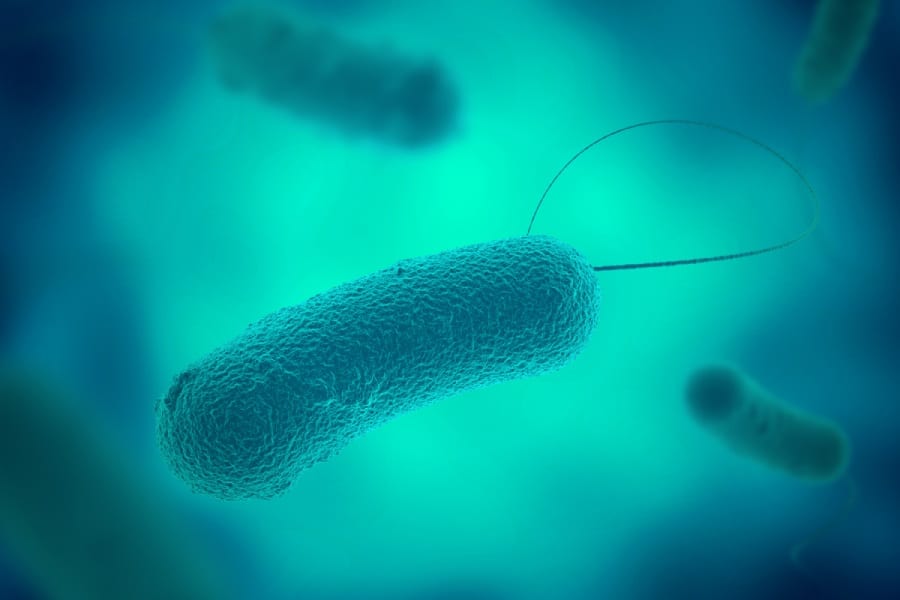The word “flagellum” basically means “whip”. Flagellum is a structure that is heavily involved in the locomotion of a cell. The flagellum is a hair-like/thread-like, microscopic structure. It is around five to 16 µm in length and 12 – 30 nm in diameter. Despite being microscopic, flagella are complex filamentous cytoplasmic structures that protrude through a cell wall.
The primary role of flagella is to help improve bacterial motility. Bacteria, such as E. coli and Vibrio cholerae, rely on motility to survive and cause diseases. More about this will be explained later. Other things we will cover in this article are the classifications of flagella, the structure of flagella, and the difference between flagella and cilia.
The Structure of Flagella
To better understand flagella, you must first know its structure. The structure of flagella is helical and made of what is known as “flagellin” protein [1]. Ideally, the structure of bacterial flagella is divided into three different sections [1]. These are:
• Filament
• Basal body
• Hook
1. Filament
This is a thin, hair-like structure that arises from the hook comprised of vast subunits of flagellin proteins that form chains.
2. Basal Body
The basal body is attached both to the cytoplasmic membrane and the cell membrane. It is made up of rings, which are surrounded by a pair of proteins referred to as “MotB”. These rings are:
• M-S ring, which is anchored in the cytoplasmic membrane
• C-ring, which is anchored in the cytoplasm
• P-ring, which is anchored in the peptidoglycan layer
• L-ring, which is the outer ring. It is found in gram positive bacteria and anchored in the lipopolysaccharide.
3. Hook
This is a wider area found at the filament’s base. It connects the filament to the motor protein in the base.
Classifications of Flagella
It is very important to know the structure of flagella because this, to some extent, helps you better understand their classification. Flagella come in four key types, which are [2]:
1. Amphitrichous
These are single flagellum found on both ends of an organism. They are known as polar flagellum and can rotate anti-clockwise and clockwise. When they rotate anti-clockwise, they pull the organism backward. And when they rotate clockwise, they move the organism forward [2]. A good example of amphitrichous flagella is found in Alcaligenes faecalis [1].
2. Monotrichous
This is a single flagellum as well, but, unlike amphitrichous, it is found on either one end or the other. Monotrichous is also referred to as a polar flagellum. And, like amphitrichous, it can rotate anti-clockwise or clockwise. When it rotates anti-clockwise, the organism moves backward and when it rotates clockwise, the organism moves forward. An example of a polar monotrichous flagella is found in Pseudomonas [1], and Vibrio cholerae.
3. Lophotrichous
As opposed to amphitrichous and monotrichous, lophotrichous refers to innumerable flagella at either one end of an organism or the other. Lophotrichous are also referred to as polar flagella, and they can rotate clockwise or anti-clockwise. When they rotate clockwise, they move the organism forward and when they rotate anti-clockwise, they move the organism backward. An example of lophotrichous flagella is found in Spirillum [1].
4. Peritrichous
Peritrichous refer to lots of flagella that are attached all over an organism. Unlike the other three we have already discussed, peritrichous are non-polar flagella. And that is because they are all over the organism. Peritrichous rotate anti-clockwise and create a bundle, which moves the organism in a single direction. If some of the flagella under peritrichous break and start to rotate clockwise, the organism will not move in any direction and, instead, begin to tumble. A good example of peritrichous flagella is found in Salmonella typhi [1].
Other types of flagella are atrichous, which refers to no flagellum, and cephalotrichous, which refers to countless flagella found at both ends of an organism. Cephalotrichous flagella move just like monotrichous. An example of cephalotrichous flagella and atrichous flagella are found in some types of pseudomonas bacteria and some types of lactobacillus respectively.
How Flagella Help Bacteria
Flagella mostly promote virulence, which is the harmfulness or severity of a bacterium or virus. Flagella achieve virulence by promoting motility. High motility increases virulence in most bacteria [4].
An experiment conducted on Vibrio cholerae, which, as mentioned earlier, has a single polar flagellum, showed that this bacterium in mice had a significantly decreased virulence when the flagellum was disabled [5]. The bacterium was not motile and had notably lower adsorption through the intestine.
Bacterial species also rely on flagella to facilitate adhesion. Examples of bacterial species that do this are Pseudomonas aeruginosa and E. coli. Ideally, different sub-types of E. coli utilize flagella for adhesion at different levels.
Other functions of bacterial flagella include detecting changes in temperature and pH and identifying certain types of organisms [2]. Although this is not related to helping bacteria, flagella help eukaryotes enhance their rates of reproduction.
Flagellum in Bacteria Performs the Following Functions:
• Facilitate virulence
• Promote movement and locomotion
• Enhance adhesion
• Facilitate sensation
• Promote signal transduction
Difference Between Flagella and Cilia
Flagella and cilia are often confused, but the two are completely different. Here are the key differences between each one of them.
• Cilia fuse into some protozoans to create what is referred to as “cirri”. Flagella, on the other hand, normally do not fuse [2].
• Cilia are present in huge numbers, whereas, flagella are present in small numbers [2].
• Cilia demonstrate a beating motion, while flagella demonstrate a coiled motion [2].
• Cilia normally cover the entire cell. Flagella, on the other hand, cover one end of the cell [2].
Another thing to note is that, while cilia have the same function as flagella, and are used for locomotion, they are shorter. Plus, their movement is different.
Wrap-Up
In summary, flagella are hair-like appendages that protrude from many different microbes called flagellates. Flagella mostly help improve motility in a wide range of bacterial species. Motility, in return, help facilitate virulence. Ideally, there are different types of flagella, including amphitrichous, monotrichous, peritrichous, and lophotrichous. Flagella are also different from cilia, and their structure consists of a hook, basal body, and filament.
Crestone is one of your leading biotech companies in Boulder that focuses on medical research in Colorado to combat antimicrobial resistance.
References
- Tankeshwar, Acharya. “Flagella: Structure, Arrangement, Function.” Microbe Online, Microbe Online, 4 Oct. 2022, https://microbeonline.com/bacterial-flagella-structure-importance-and-examples-of-flagellated-bacteria/.
- “Flagella- Structure, Types and Function of Flagella.” BYJUS, BYJU’S, 21 Sept. 2022, https://byjus.com/biology/flagella/.
- “Flagella and Cilia: Definition, Structure & Types.” Embibe Exams, 31 Oct. 2022, https://www.embibe.com/exams/flagella-and-cilia/.
- Greenwood, Michael. “The Role of Flagella in Adhesion and Virulence.” News, 4 Oct. 2021, https://www.news-medical.net/life-sciences/The-Role-of-Flagella-in-Adhesion-and-Virulence.aspx.
- Utada, Andrew S, et al. “Vibrio Cholerae Use Pili and Flagella Synergistically to Effect Motility Switching and Conditional Surface Attachment.” Nature Communications, U.S. National Library of Medicine, 19 Sept. 2014, https://www.ncbi.nlm.nih.gov/pmc/articles/PMC4420032/.

